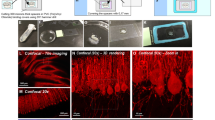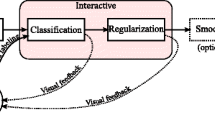Abstract
Connectomics based on high resolution ssTEM imagery requires reconstruction of the neuron geometry from histological slides. We present an approach for the automatic membrane segmentation in anisotropic stacks of electron microscopy brain tissue sections. The ambiguities in neuronal segmentation of a section are resolved by using the context from the neighboring sections. We find the global dense correspondence between the sections by SIFT Flow algorithm, evaluate the features of the corresponding pixels and use them to perform the segmentation. Our method is 3.6 and 6.4% more accurate in two different accuracy metrics than the algorithm with no context from other sections.
Chapter PDF
Similar content being viewed by others
References
Advanced Weka Segmentation (Fiji), http://bit.ly/MdCr0v
ISBI 2012 challenge, http://bit.ly/riGDUm
Boykov, Y., Kolmogorov, V.: An experimental comparison of min-cut/max-flow algorithms for energy minimization in vision. Trans. Pattern Anal. Mach. Intell. 26, 1124–1137 (2004)
Breiman, L.: Random forests. Machine Learning 45(1), 5–32 (2001)
Cardona, A., Saalfeld, S., Preibisch, S., Schmid, B., Pulokas, A.C.J., Tomancak, P., Hartenstein, V.: An integrated micro- and macroarchitectural analysis of the drosophila brain by computer-assisted serial section electron microscopy. PLoS Biol. 10 (2010)
Jain, V., Bollmann, B., Richardson, M., Berger, D.R., Helmstaedter, M., Briggman, K.L., Denk, W., Bowden, J.B., Mendenhall, J.M., Abraham, W.C., Harris, K.M., Kasthuri, N., Hayworth, K.J., Schalek, R., Tapia, J.C., Lichtman, J.W., Seung, H.S.: Boundary learning by optimization with topological constraints. In: CVPR, pp. 2488–2495 (2010)
Kaynig, V., Fuchs, T.J., Buhmann, J.M.: Geometrical Consistent 3D Tracing of Neuronal Processes in ssTEM Data. In: Jiang, T., Navab, N., Pluim, J.P.W., Viergever, M.A. (eds.) MICCAI 2010, Part II. LNCS, vol. 6362, pp. 209–216. Springer, Heidelberg (2010)
Kaynig, V., Fuchs, T.J., Buhmann, J.M.: Neuron geometry extraction by perceptual grouping in sstem images. In: CVPR, pp. 2902–2909. IEEE (2010)
Kumar, R., Reina, A.V., Pfister, H.: Radon-like features and their application to connectomics. In: MMBIA. IEEE (2010)
Liu, C., Yuen, J., Torralba, A.: Sift flow: Dense correspondence across scenes and its applications. Trans. Pattern Anal. Mach. Intell. 33(5), 978–994 (2011)
Lowe, D.G.: Object recognition from local scale-invariant features. In: ICCV, p. 1150. IEEE (1999)
Lucchi, A., Smith, K., Achanta, R., Lepetit, V., Fua, P.: A Fully Automated Approach to Segmentation of Irregularly Shaped Cellular Structures in EM Images. In: Jiang, T., Navab, N., Pluim, J.P.W., Viergever, M.A. (eds.) MICCAI 2010, Part II. LNCS, vol. 6362, pp. 463–471. Springer, Heidelberg (2010)
Sandberg, K., Brega, M.: Segmentation of thin structures in electron micrographs using orientation fields. Journal of Structural Biology 157(2), 403–415 (2007)
Vasilevskiy, A., Siddiqi, K.: Flux maximizing geometric flows. Trans. Pattern Anal. Mach. Intell. 24, 1565–1578 (2001)
Vazquez-Reina, A., Huang, D., Gelbart, M., Lichtman, J., Miller, E., Pfister, H.: Segmentation fusion for connectomics. In: ICCV. IEEE (2011)
Author information
Authors and Affiliations
Editor information
Editors and Affiliations
Rights and permissions
Copyright information
© 2012 Springer-Verlag Berlin Heidelberg
About this paper
Cite this paper
Laptev, D., Vezhnevets, A., Dwivedi, S., Buhmann, J.M. (2012). Anisotropic ssTEM Image Segmentation Using Dense Correspondence across Sections. In: Ayache, N., Delingette, H., Golland, P., Mori, K. (eds) Medical Image Computing and Computer-Assisted Intervention – MICCAI 2012. MICCAI 2012. Lecture Notes in Computer Science, vol 7510. Springer, Berlin, Heidelberg. https://doi.org/10.1007/978-3-642-33415-3_40
Download citation
DOI: https://doi.org/10.1007/978-3-642-33415-3_40
Publisher Name: Springer, Berlin, Heidelberg
Print ISBN: 978-3-642-33414-6
Online ISBN: 978-3-642-33415-3
eBook Packages: Computer ScienceComputer Science (R0)




